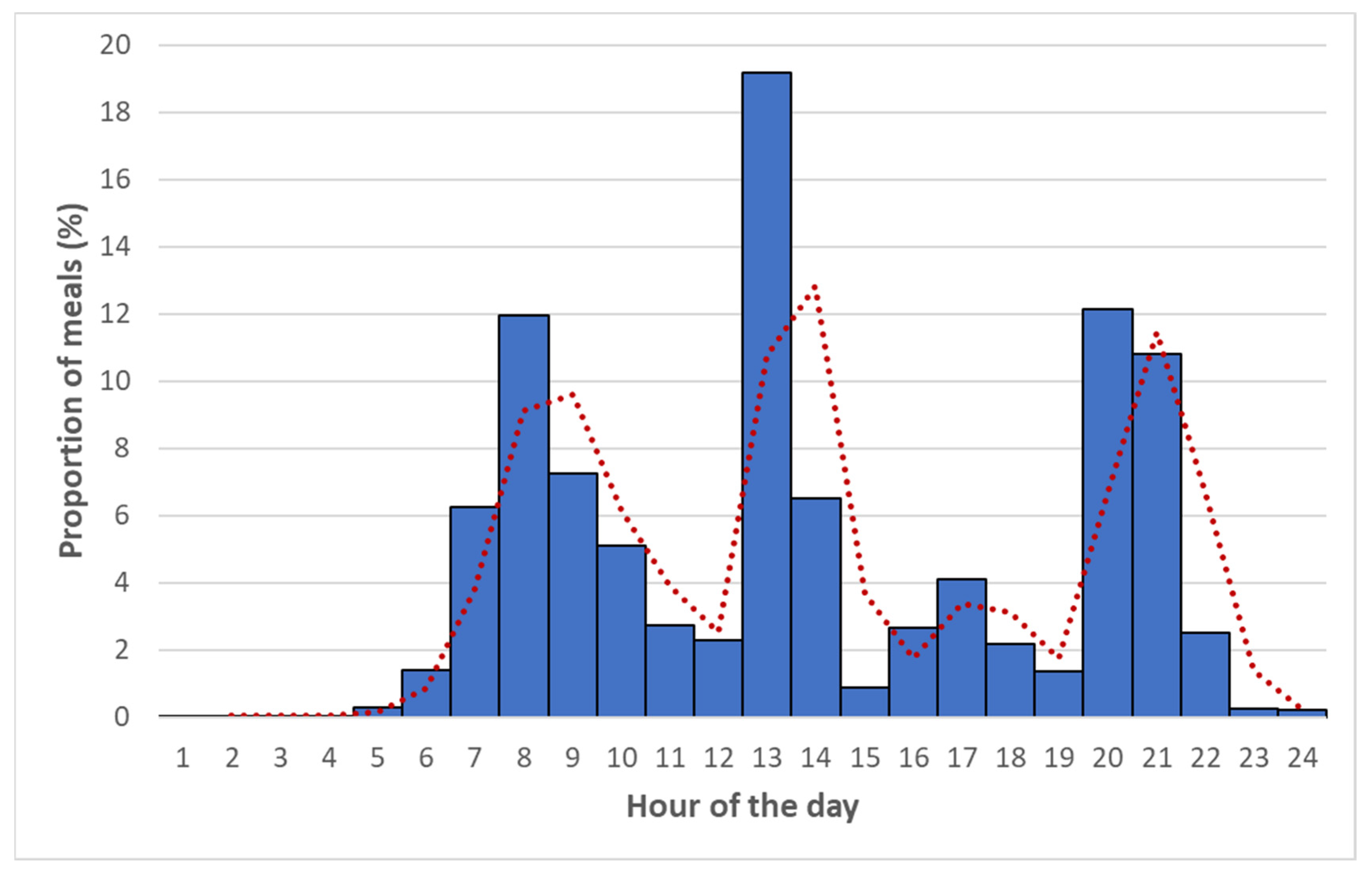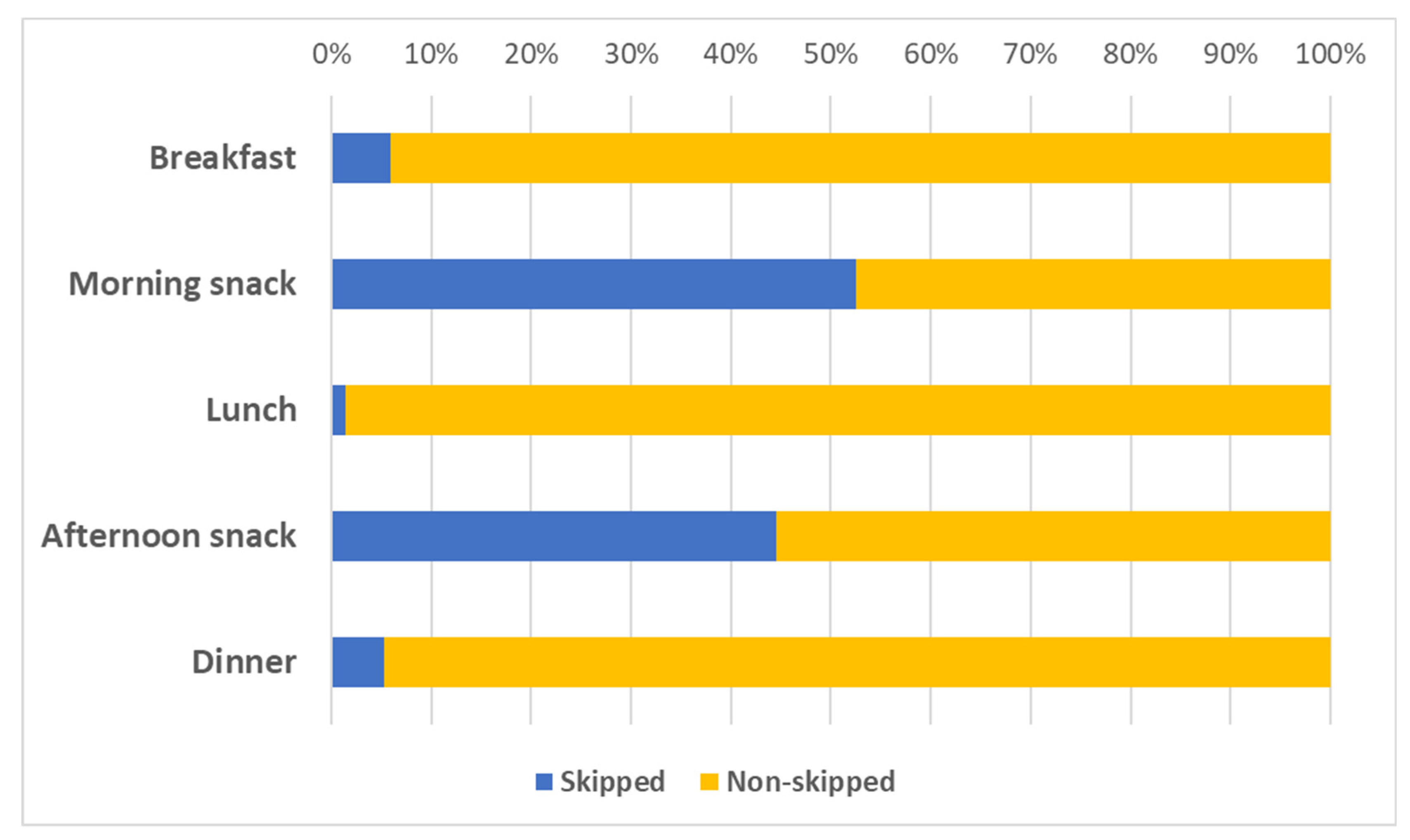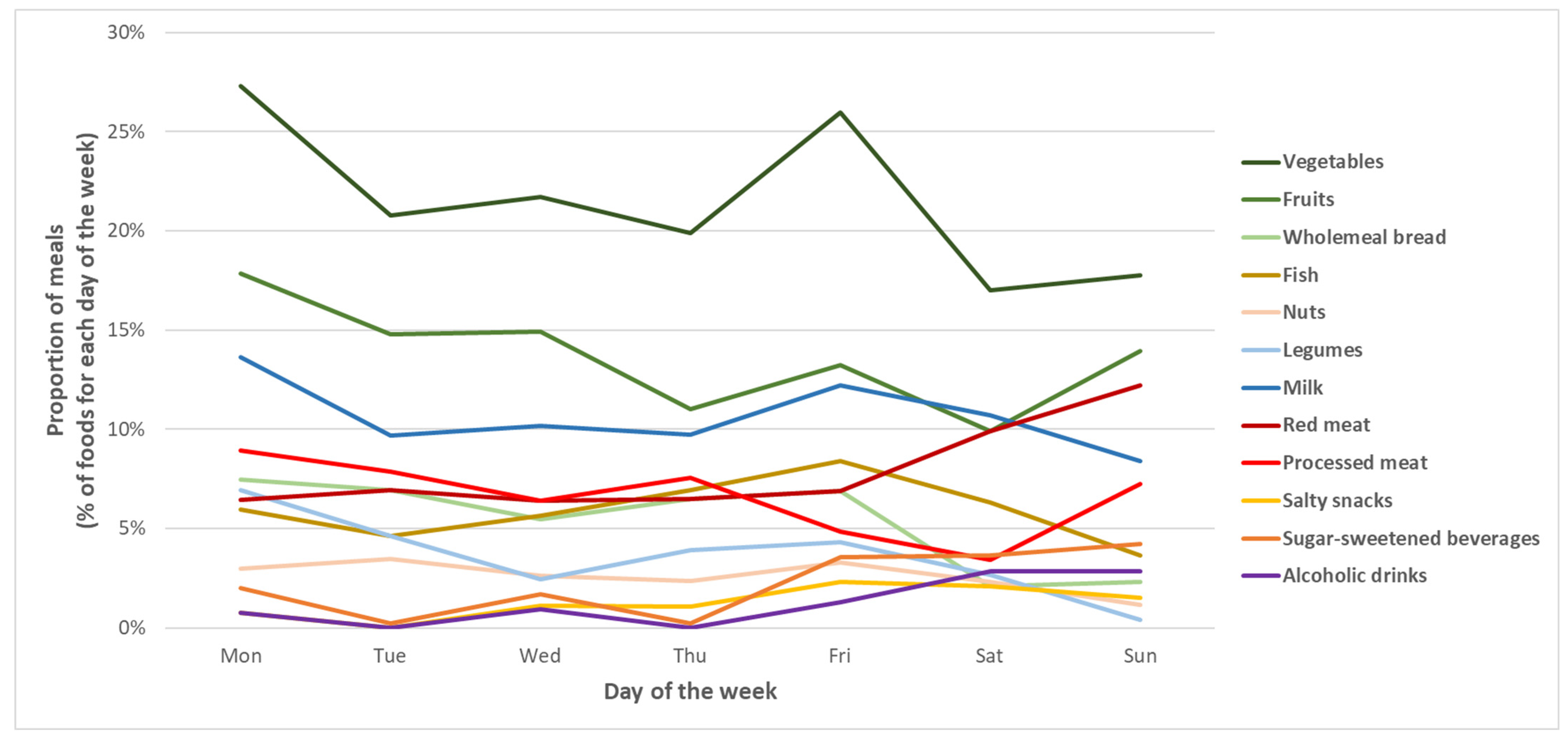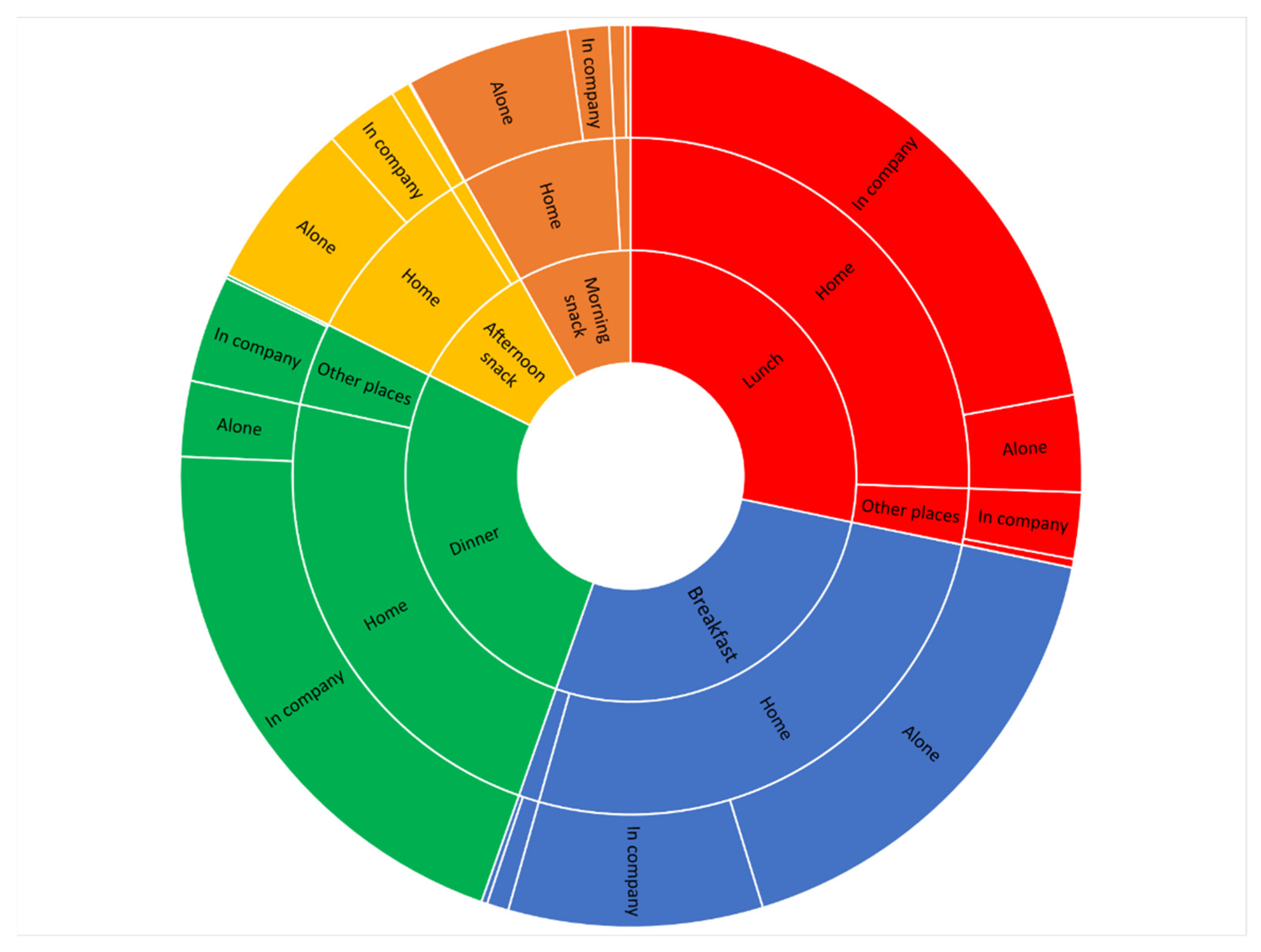Impact of Eating Context on Dietary Choices of College Students: Evidence from the HEALTHY-UNICT Project
Abstract
1. Introduction
2. Materials and Methods
2.1. Study Design and Popuation
2.2. Data Collection
2.3. Statistical Analysis
3. Results
3.1. Population Characteristics
3.2. Characteristics of Eating Episodes
3.3. Association of Eating Context with Dietary Choices
3.4. Clusters of Eating Episodes
4. Discussion
Author Contributions
Funding
Institutional Review Board Statement
Informed Consent Statement
Data Availability Statement
Conflicts of Interest
References
- Poobalan, A.S.; Aucott, L.S.; Clarke, A.; Smith, W.C. Diet behaviour among young people in transition to adulthood (18–25 year olds): A mixed method study. Health Psychol. Behav. Med. 2014, 2, 909–928. [Google Scholar] [CrossRef] [PubMed]
- Maugeri, A.; Barchitta, M.; Kunzova, S.; Bauerova, H.; Agodi, A.; Vinciguerra, M. The association of social and behavioral factors with dietary risks in adults: Evidence from the Kardiovize Brno 2030 study. Nutr. Metab. Cardiovasc. Dis. 2020, 30, 896–906. [Google Scholar] [CrossRef]
- Maugeri, A.; Barchitta, M.; Fiore, V.; Rosta, G.; Favara, G.; La Mastra, C.; La Rosa, M.C.; Magnano San Lio, R.; Agodi, A. Determinants of Adherence to the Mediterranean Diet: Findings from a Cross-Sectional Study in Women from Southern Italy. Int. J. Environ. Res. Public Health 2019, 16, 2963. [Google Scholar] [CrossRef] [PubMed]
- Maugeri, A.; Barchitta, M.; Agrifoglio, O.; Favara, G.; La Mastra, C.; La Rosa, M.C.; Magnano San Lio, R.; Panella, M.; Cianci, A.; Agodi, A. The impact of social determinants and lifestyles on dietary patterns during pregnancy: Evidence from the “Mamma & Bambino” study. Ann. Ig. 2019, 31, 81–89. [Google Scholar] [PubMed]
- Goldschmidt, A.B.; Smith, K.E.; Crosby, R.D.; Boyd, H.K.; Dougherty, E.; Engel, S.G.; Haedt-Matt, A. Ecological momentary assessment of maladaptive eating in children and adolescents with overweight or obesity. Int. J. Eat. Disord. 2018, 51, 549–557. [Google Scholar] [CrossRef] [PubMed]
- Kassebaum, N.; Kyu, H.H.; Zoeckler, L.; Olsen, H.E.; Thomas, K.; Pinho, C.; Bhutta, Z.A.; Dandona, L.; Ferrari, A.; Ghiwot, T.T.; et al. Child and Adolescent Health From 1990 to 2015: Findings from the Global Burden of Diseases, Injuries, and Risk Factors 2015 Study. JAMA Pediatr. 2017, 171, 573–592. [Google Scholar] [CrossRef] [PubMed]
- Hobbs, M.; Pearson, N.; Foster, P.J.; Biddle, S.J. Sedentary behaviour and diet across the lifespan: An updated systematic review. Br. J. Sports Med. 2015, 49, 1179–1188. [Google Scholar] [CrossRef] [PubMed]
- Diethelm, K.; Huybrechts, I.; Moreno, L.; De Henauw, S.; Manios, Y.; Beghin, L.; González-Gross, M.; Le Donne, C.; Cuenca-García, M.; Castillo, M.J.; et al. Nutrient intake of European adolescents: Results of the HELENA (Healthy Lifestyle in Europe by Nutrition in Adolescence) Study. Public Health Nutr. 2014, 17, 486–497. [Google Scholar] [CrossRef]
- World Health Organization. Adolescent Health. Available online: https://www.who.int/health-topics/adolescent-health#tab=tab_1 (accessed on 15 September 2022).
- Bruening, M.; van Woerden, I.; Todd, M.; Brennhofer, S.; Laska, M.N.; Dunton, G. A Mobile Ecological Momentary Assessment Tool (devilSPARC) for Nutrition and Physical Activity Behaviors in College Students: A Validation Study. J. Med. Internet Res. 2016, 18, e209. [Google Scholar] [CrossRef]
- Barchitta, M.; Maugeri, A.; Agrifoglio, O.; Favara, G.; La Mastra, C.; La Rosa, M.C.; Magnano San Lio, R.; Agodi, A. Comparison of Self-Administered Web-Based and Interviewer Printed Food Frequency Questionnaires for Dietary Assessment in Italian Adolescents. Int. J. Environ. Res. Public Health 2019, 16, 1949. [Google Scholar] [CrossRef]
- Lodato, F.; Araújo, J.; Barros, H.; Lopes, C.; Agodi, A.; Barchitta, M.; Ramos, E. Caffeine intake reduces sleep duration in adolescents. Nutr. Res. 2013, 33, 726–732. [Google Scholar] [CrossRef] [PubMed]
- Barchitta, M.; Maugeri, A.; Agrifoglio, O.; Favara, G.; La Mastra, C.; La Rosa, M.C.; Magnano San Lio, R.; Agodi, A. Dietary patterns and school performance: Evidence from a sample of adolescents in Sicily, Italy. Ann. Ig. 2019, 31 (Suppl. S1), 72–80. [Google Scholar] [PubMed]
- Correa-Burrows, P.; Burrows, R.; Orellana, Y.; Ivanovic, D. The relationship between unhealthy snacking at school and academic outcomes: A population study in Chilean schoolchildren. Public Health Nutr. 2015, 18, 2022–2030. [Google Scholar] [CrossRef] [PubMed]
- Santomauro, F.; Lorini, C.; Tanini, T.; Indiani, L.; Lastrucci, V.; Comodo, N.; Bonaccorsi, G. Adherence to Mediterranean diet in a sample of Tuscan adolescents. Nutrition 2014, 30, 1379–1383. [Google Scholar] [CrossRef] [PubMed]
- Maugeri, A.; Kunzova, S.; Medina-Inojosa, J.R.; Agodi, A.; Barchitta, M.; Homolka, M.; Kiacova, N.; Bauerova, H.; Sochor, O.; Lopez-Jimenez, F.; et al. Association between eating time interval and frequency with ideal cardiovascular health: Results from a random sample Czech urban population. Nutr. Metab. Cardiovasc. Dis. 2018, 28, 847–855. [Google Scholar] [CrossRef] [PubMed]
- Kabir, A.; Miah, S.; Islam, A. Factors influencing eating behavior and dietary intake among resident students in a public university in Bangladesh: A qualitative study. PLoS ONE 2018, 13, e0198801. [Google Scholar] [CrossRef]
- Campbell, K.L.; Babiarz, A.; Wang, Y.; Tilton, N.A.; Black, M.M.; Hager, E.R. Factors in the home environment associated with toddler diet: An ecological momentary assessment study. Public Health Nutr. 2018, 21, 1855–1864. [Google Scholar] [CrossRef]
- Goldschmidt, A.B.; Crosby, R.D.; Cao, L.; Pearson, C.M.; Utzinger, L.M.; Pacanowski, C.R.; Mason, T.B.; Berner, L.A.; Engel, S.G.; Wonderlich, S.A.; et al. Contextual factors associated with eating in the absence of hunger among adults with obesity. Eat. Behav. 2017, 26, 33–39. [Google Scholar] [CrossRef]
- Elliston, K.G.; Ferguson, S.G.; Schüz, N.; Schüz, B. Situational cues and momentary food environment predict everyday eating behavior in adults with overweight and obesity. Health Psychol. 2017, 36, 337–345. [Google Scholar] [CrossRef]
- McMinn, D.; Allan, J.L. The SNAPSHOT study protocol: SNAcking, Physical activity, Self-regulation, and Heart rate Over Time. BMC Public Health 2014, 14, 1006. [Google Scholar] [CrossRef]
- Shams-White, M.M.; Korycinski, R.W.; Dodd, K.W.; Barrett, B.; Jacobs, S.; Subar, A.F.; Park, Y.; Bowles, H.R. Examining the association between meal context and diet quality: An observational study of meal context in older adults. Int. J. Behav. Nutr. Phys. Act. 2021, 18, 67. [Google Scholar] [CrossRef] [PubMed]
- Briefel, R.R.; Crepinsek, M.K.; Cabili, C.; Wilson, A.; Gleason, P.M. School food environments and practices affect dietary behaviors of US public school children. J. Am. Diet. Assoc. 2009, 109, S91–S107. [Google Scholar] [CrossRef] [PubMed]
- Woodruff, S.J.; Hanning, R.M.; McGoldrick, K. The influence of physical and social contexts of eating on lunch-time food intake among southern Ontario, Canada, middle school students. J. Sch. Health 2010, 80, 421–428. [Google Scholar] [CrossRef] [PubMed]
- Maugeri, A.; Barchitta, M. A Systematic Review of Ecological Momentary Assessment of Diet: Implications and Perspectives for Nutritional Epidemiology. Nutrients 2019, 11, 2696. [Google Scholar] [CrossRef] [PubMed]
- Barchitta, M.; Maugeri, A.; Favara, G.; Magnano San Lio, R.; Riela, P.M.; Guarnera, L.; Battiato, S.; Agodi, A. Development of a Web-App for the Ecological Momentary Assessment of Dietary Habits among College Students: The HEALTHY-UNICT Project. Nutrients 2022, 14, 330. [Google Scholar] [CrossRef]
- Lachat, C.; Nago, E.; Verstraeten, R.; Roberfroid, D.; Van Camp, J.; Kolsteren, P. Eating out of home and its association with dietary intake: A systematic review of the evidence. Obes. Rev. 2012, 13, 329–346. [Google Scholar] [CrossRef]
- Orfanos, P.; Naska, A.; Trichopoulou, A.; Grioni, S.; Boer, J.M.; van Bakel, M.M.; Ericson, U.; Rohrmann, S.; Boeing, H.; Rodríguez, L.; et al. Eating out of home: Energy, macro- and micronutrient intakes in 10 European countries. The European Prospective Investigation into Cancer and Nutrition. Eur. J. Clin. Nutr. 2009, 63 (Suppl. S4), S239–S262. [Google Scholar] [CrossRef]
- Lachat, C.; Khanh, L.N.; Khan, N.C.; Dung, N.Q.; Nguyen, d.V.; Roberfroid, D.; Kolsteren, P. Eating out of home in Vietnamese adolescents: Socioeconomic factors and dietary associations. Am. J. Clin. Nutr. 2009, 90, 1648–1655. [Google Scholar] [CrossRef]
- Llanaj, E.; Ádány, R.; Lachat, C.; D’Haese, M. Examining food intake and eating out of home patterns among university students. PLoS ONE 2018, 13, e0197874. [Google Scholar] [CrossRef]
- Magnano San Lio, R.; Barchitta, M.; Maugeri, A.; La Rosa, M.C.; Giunta, G.; Panella, M.; Cianci, A.; Galvani, F.; Pappalardo, E.; Ettore, G.; et al. The Impact of the COVID-19 Pandemic on Dietary Patterns of Pregnant Women: A Comparison between Two Mother-Child Cohorts in Sicily, Italy. Nutrients 2022, 14, 3380. [Google Scholar] [CrossRef]




| Foods | Characteristics of Eating Episodes | OR | 95%CI | p-Value |
|---|---|---|---|---|
| Vegetables | Eating away from home vs. at home | 0.52 | 0.36–0.76 | 0.001 |
| Eating with company vs. alone | 3.09 | 2.31–4.13 | <0.001 | |
| Fruits | Eating away from home vs. at home | 0.28 | 0.16–0.51 | <0.001 |
| Eating with company vs. alone | 0.88 | 0.68–1.13 | 0.308 | |
| Red meat | Eating away from home vs. at home | 0.83 | 0.51–1.35 | 0.455 |
| Eating with company vs. alone | 4.39 | 2.51–7.65 | <0.001 | |
| Processed meat | Eating away from home vs. at home | 1.81 | 1.12–2.92 | 0.015 |
| Eating with company vs. alone | 1.13 | 0.73–1.75 | 0.594 | |
| Fish | Eating away from home vs. at home | 1.03 | 0.61–1.75 | 0.906 |
| Eating with company vs. alone | 9.34 | 4.22–20.65 | <0.001 | |
| Wholemeal bread | Eating away from home vs. at home | 0.43 | 0.17–1.08 | 0.073 |
| Eating with company vs. alone | 0.90 | 0.56–1.44 | 0.660 | |
| Nuts | Eating away from home vs. at home | 0.22 | 0.03–1.58 | 0.131 |
| Eating with company vs. alone | 0.27 | 0.15–0.48 | <0.001 | |
| Legumes | Eating away from home vs. at home | 0.13 | 0.01–0.95 | 0.044 |
| Eating with company vs. alone | 3.03 | 1.56–5.88 | 0.001 | |
| Milk | Eating away from home vs. at home | 0.53 | 0.24–1.18 | 0.122 |
| Eating with company vs. alone | 1.51 | 1.11–2.06 | 0.009 | |
| Salty snacks | Eating away from home vs. at home | 4.25 | 2.17–8.31 | <0.001 |
| Eating with company vs. alone | 1.63 | 0.69–3.85 | 0.265 | |
| Sugar-sweetened beverages | Eating away from home vs. at home | 1.63 | 0.88–3.03 | 0.119 |
| Eating with company vs. alone | 3.55 | 1.58–7.99 | 0.002 | |
| Alcoholic drinks | Eating away from home vs. at home | 18.42 | 7.04–48.21 | <0.001 |
| Eating with company vs. alone | 3.98 | 0.52–30.31 | 0.183 |
| Characteristics | Cluster 1 | Cluster 2 | Cluster 3 | Cluster 4 | p-Value |
|---|---|---|---|---|---|
| Meal type | |||||
| Breakfast | 11.1% | 13.7% | 45.0% | 32.8% | <0.001 |
| Morning snack | 7.2% | 3.5% | 19.5% | 3.8% | |
| Lunch | 28.7% | 38.6% | 10.6% | 32.2% | |
| Afternoon snack | 8.6% | 5.6% | 18.8% | 5.9% | |
| Dinner | 44.4% | 38.6% | 6.2% | 25.3% | |
| Day of the week | |||||
| Workweek | 49.1% | 100.0% | 100.0% | 0.0% | <0.001 |
| Weekend | 50.9% | 0.0% | 0.0% | 100.0% | |
| Meal location | |||||
| At home | 24.0% | 100.0% | 100.0% | 100.0% | <0.001 |
| At work/university | 15.8% | 0.0% | 0.0% | 0.0% | |
| Public closed space | 16.8% | 0.0% | 0.0% | 0.0% | |
| Public open space | 43.4% | 0.0% | 0.0% | 0.0% | |
| Social context | |||||
| Alone | 7.5% | 0.0% | 100.0% | 31.3% | <0.001 |
| With family | 24.7% | 100.0% | 0.0% | 68.7% | |
| With friends | 56.3% | 0.0% | 0.0% | 0.0% | |
| With colleagues | 11.5% | 0.0% | 0.0% | 0.0% | |
Publisher’s Note: MDPI stays neutral with regard to jurisdictional claims in published maps and institutional affiliations. |
© 2022 by the authors. Licensee MDPI, Basel, Switzerland. This article is an open access article distributed under the terms and conditions of the Creative Commons Attribution (CC BY) license (https://creativecommons.org/licenses/by/4.0/).
Share and Cite
Maugeri, A.; Magnano San Lio, R.; Favara, G.; La Rosa, M.C.; La Mastra, C.; Riela, P.M.; Guarnera, L.; Battiato, S.; Barchitta, M.; Agodi, A. Impact of Eating Context on Dietary Choices of College Students: Evidence from the HEALTHY-UNICT Project. Nutrients 2022, 14, 4418. https://doi.org/10.3390/nu14204418
Maugeri A, Magnano San Lio R, Favara G, La Rosa MC, La Mastra C, Riela PM, Guarnera L, Battiato S, Barchitta M, Agodi A. Impact of Eating Context on Dietary Choices of College Students: Evidence from the HEALTHY-UNICT Project. Nutrients. 2022; 14(20):4418. https://doi.org/10.3390/nu14204418
Chicago/Turabian StyleMaugeri, Andrea, Roberta Magnano San Lio, Giuliana Favara, Maria Clara La Rosa, Claudia La Mastra, Paolo Marco Riela, Luca Guarnera, Sebastiano Battiato, Martina Barchitta, and Antonella Agodi. 2022. "Impact of Eating Context on Dietary Choices of College Students: Evidence from the HEALTHY-UNICT Project" Nutrients 14, no. 20: 4418. https://doi.org/10.3390/nu14204418
APA StyleMaugeri, A., Magnano San Lio, R., Favara, G., La Rosa, M. C., La Mastra, C., Riela, P. M., Guarnera, L., Battiato, S., Barchitta, M., & Agodi, A. (2022). Impact of Eating Context on Dietary Choices of College Students: Evidence from the HEALTHY-UNICT Project. Nutrients, 14(20), 4418. https://doi.org/10.3390/nu14204418









